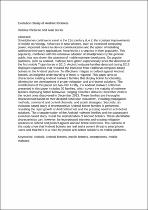JavaScript is disabled for your browser. Some features of this site may not work without it.
- ResearchSpace
- →
- Research Publications/Outputs
- →
- Conference Publications
- →
- View Item
| dc.contributor.author |
Pieterse, Heloise

|
|
| dc.contributor.author |
Burke, Ivan D

|
|
| dc.date.accessioned | 2015-11-12T07:31:31Z | |
| dc.date.available | 2015-11-12T07:31:31Z | |
| dc.date.issued | 2015-03 | |
| dc.identifier.citation | Pieterse, H and Burke, I. 2015. Evolution study of android botnets. In: Proceedings of the 10th International Conference on Cyber Warfare and Security, Kruger National Park, South Africa, 24-25 March 2015, 9pp. | en_US |
| dc.identifier.uri | http://hdl.handle.net/10204/8256 | |
| dc.identifier.uri | https://www.researchgate.net/publication/274224366_Evolution_Study_of_Android_Botnets | |
| dc.description | Abstract Only. | en_US |
| dc.description.abstract | Smartphones continue to excel in the 21st century due to the constant improvements of mobile technology. Advances in smartphones, such as increased computing power, improved device-to-device communication and the option of installing additional third-party applications, have led to a sharp rise in their popularity. This popularity, combined with the extensive adoption of smartphones by the general public, has now drawn the attention of mobile malware developers. On popular platforms, such as Android, malware have grown exponentially since the detection of the first mobile Trojan horse in 2010. Android malware families detected during 2013 displayed capabilities that revealed the transition from traditional computer-based botnets to the Android platform. To effectively mitigate or defend against Android botnets, an insightful understanding of them is required. This paper aims to characterise existing Android malware families that display botnet functionality, allowing for the development of proper mitigation and anti-botnet solutions. The contributions of this paper are two-fold. Firstly, the Android malware collection presented in this paper includes 20 families, which covers the majority of malware families displaying botnet behaviour, ranging from their debut in December 2010 to the recent ones discovered in December 2013. These families are thoroughly characterised based on their detailed behaviour breakdown, including propagation methods, command and control channels, and attack strategies. Secondly, an evolution-based study of representative Android botnet families is performed, revealing the rapid growth of Android botnets and the pressing need for anti-botnet solutions. The characterisation of the Android malware families and the subsequent evolution-based study reveal the sophistication of Android botnets. These identifiable characteristics can, however, be incorporated into new and existing mitigation solutions to defend and protect against Android botnet infections. The outcome of this study show that Android botnets are real and a current threat to smartphone users and that there is a need for proper anti-botnet solutions on mobile platforms. | en_US |
| dc.language.iso | en | en_US |
| dc.relation.ispartofseries | Worklist;15814 | |
| dc.subject | Android | en_US |
| dc.subject | Android botnets | en_US |
| dc.subject | Mobile botnets | en_US |
| dc.subject | Smartphones | en_US |
| dc.subject | Mobile malware | en_US |
| dc.title | Evolution study of android botnets | en_US |
| dc.type | Conference Presentation | en_US |
| dc.identifier.apacitation | Pieterse, H., & Burke, I. D. (2015). Evolution study of android botnets. http://hdl.handle.net/10204/8256 | en_ZA |
| dc.identifier.chicagocitation | Pieterse, Heloise, and Ivan D Burke. "Evolution study of android botnets." (2015): http://hdl.handle.net/10204/8256 | en_ZA |
| dc.identifier.vancouvercitation | Pieterse H, Burke ID, Evolution study of android botnets; 2015. http://hdl.handle.net/10204/8256 . | en_ZA |
| dc.identifier.ris | TY - Conference Presentation AU - Pieterse, Heloise AU - Burke, Ivan D AB - Smartphones continue to excel in the 21st century due to the constant improvements of mobile technology. Advances in smartphones, such as increased computing power, improved device-to-device communication and the option of installing additional third-party applications, have led to a sharp rise in their popularity. This popularity, combined with the extensive adoption of smartphones by the general public, has now drawn the attention of mobile malware developers. On popular platforms, such as Android, malware have grown exponentially since the detection of the first mobile Trojan horse in 2010. Android malware families detected during 2013 displayed capabilities that revealed the transition from traditional computer-based botnets to the Android platform. To effectively mitigate or defend against Android botnets, an insightful understanding of them is required. This paper aims to characterise existing Android malware families that display botnet functionality, allowing for the development of proper mitigation and anti-botnet solutions. The contributions of this paper are two-fold. Firstly, the Android malware collection presented in this paper includes 20 families, which covers the majority of malware families displaying botnet behaviour, ranging from their debut in December 2010 to the recent ones discovered in December 2013. These families are thoroughly characterised based on their detailed behaviour breakdown, including propagation methods, command and control channels, and attack strategies. Secondly, an evolution-based study of representative Android botnet families is performed, revealing the rapid growth of Android botnets and the pressing need for anti-botnet solutions. The characterisation of the Android malware families and the subsequent evolution-based study reveal the sophistication of Android botnets. These identifiable characteristics can, however, be incorporated into new and existing mitigation solutions to defend and protect against Android botnet infections. The outcome of this study show that Android botnets are real and a current threat to smartphone users and that there is a need for proper anti-botnet solutions on mobile platforms. DA - 2015-03 DB - ResearchSpace DP - CSIR KW - Android KW - Android botnets KW - Mobile botnets KW - Smartphones KW - Mobile malware LK - https://researchspace.csir.co.za PY - 2015 T1 - Evolution study of android botnets TI - Evolution study of android botnets UR - http://hdl.handle.net/10204/8256 ER - | en_ZA |






